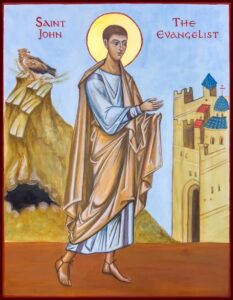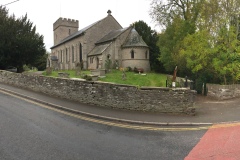
Walk into St Mary’s and you are in a church that is loved: the wood is polished, the brass gleams, candles burn by the statue of Holy Mary, and around and about hang icons of the saints. Turn away from the altar and look up and you see the superb Bevington Organ in its Italianate case of gilded light oak.
One of the surprising features of St Mary’s is its distance from the centre of town, it seems to be almost at the edge. There’s a reason for this. Historically the church would have been close to the castle and, in Norman times, the castle was sited on the mound just to the east of the church. The present castle and town walls were built later, leaving the church outside the town walls.
St Mary’s, like other churches, was buffeted by outside forces – the Reformation and the English Civil War – and it suffered its fair share of absentee vicars, priests who had a second, richer and more comfortable, parish elsewhere. By 1827 the building was in such a dire state of repair that the church wardens were summoned to appear before the Consistory Court at Brecon to answer for their neglect of duties.
This was the position when Humphrey Allen came to Hay as curate in 1825. He was a man of drive and vision and he had a considerable private fortune. It was largely due to his energy and gifts that the church was almost entirely rebuilt in 1833; the only part of the older building that remains is the 15th century tower (the battlemented top is 19th century). The new building, in late Georgian Gothic style, has a long gallery supported on cast-iron columns to provide extra seating, and an elaborate Italianate pulpit.
The most recent addition to St Mary’s, and a very splendid one, is the 3-manual, 2,000 pipe Victorian organ, which sits in the loft at the west end of the church. This came in 2010 from Holmer Church, Hereford, and is one of the finest instruments in the area (see The Bevington Organ).
Recent restoration work
Much restoration work has been done at St Mary’s over the past 20 years. Phase 1-3 is now complete: re-roofing, repairs to the stonework and guttering, re-wiring, new lighting, the addition of toilets and a kitchenette in the tower. The money for this was raised locally and with the help of generous grants from the Heritage Lottery Fund, Cadw, and the Listed Places of Worship Scheme. Phase 4-5 is ongoing and covers the provision of an emergency door through the north wall, renewal of the central heating system, and ramped access for buggies and wheelchairs.



The Christian Icons
The Christian icons that hang in St Mary’s are the work of British/Polish artist Christina Watson. Christina studied under Aidan Hart, and with Brian Bessant, both well known for their devotion to, and work on, Icons. She has also spent time in Bethlehem with Ian Knowles at the Bethlehem Icon School, and has continued her research in Cairo, focusing on a particular iconographer from the 18th Century.
Christina has loved Christian icons since she was a small child. Her interest in gold leaf, and making paints from pigments, has led her to this more sacred type of painting, She exhibits regularly in the Hereford area, sometimes solo and sometimes in collaboration with Ukrainian icon artist Petro Birov.
For more of Christina’s work see: https://www.facebook.com/ChristinaIcons









